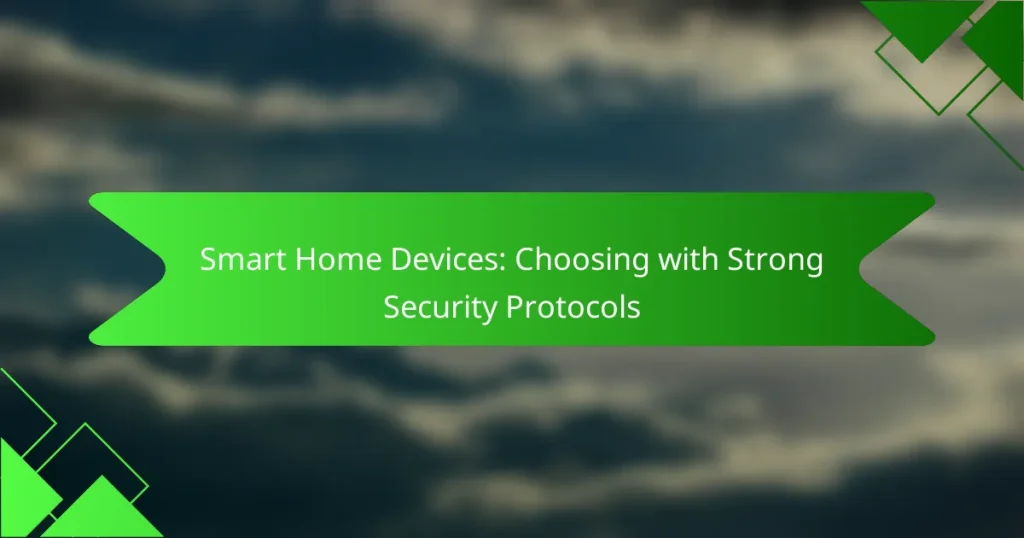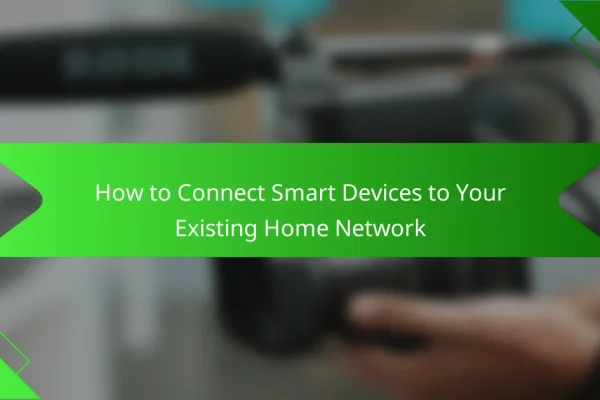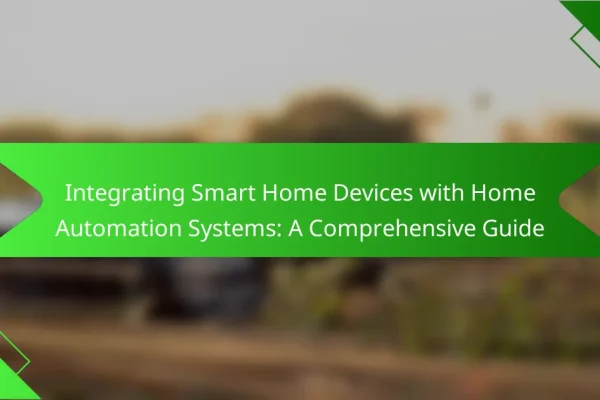
Smart Home Devices: Choosing with Strong Security Protocols
When selecting smart home devices, it is essential to prioritize those equipped with strong security…
Smart home devices are revolutionizing the way we interact with our living spaces by providing enhanced convenience, security, and energy efficiency. By connecting to the internet, these technologies automate tasks and allow users to control their home environments through mobile applications. From smart speakers to security cameras, these devices offer a variety of functionalities that improve daily living.

When selecting smart home devices, it is essential to prioritize those equipped with strong security protocols to safeguard your personal data. Look for features such as robust encryption, regular software updates, and third-party certifications, which collectively enhance your home’s security against potential threats. By choosing devices like the Amazon Echo, Google Nest Hub, or Ring…

As smart home devices become increasingly popular, ensuring their security against hacking is essential for protecting personal data and privacy. Implementing strong passwords, two-factor authentication, and regular firmware updates can significantly reduce vulnerabilities. By understanding potential weaknesses and utilizing advanced security features, homeowners can create a safer living environment. How can smart home devices be…

Smart home automation is revolutionized by AI integration, allowing devices to learn user preferences and optimize their performance for enhanced efficiency. By utilizing machine learning algorithms, these systems can adapt to individual habits, providing convenience and significant energy savings while improving overall security and comfort in the home. How does AI enhance smart home automation?…

Connecting smart devices to your existing home network can enhance your living space with convenience and automation. Whether using Wi-Fi, Ethernet, or a smart hub, it’s essential to ensure compatibility and maintain a strong signal for optimal performance. By understanding potential challenges and following best practices, you can streamline the connection process and enjoy the…

Smart home devices play a crucial role in promoting sustainability by optimizing energy consumption and enhancing overall efficiency in households. By reducing energy use and minimizing greenhouse gas emissions, these technologies contribute to a more eco-friendly living environment while also offering benefits such as resource conservation and waste reduction. How do smart home devices reduce…

When comparing Amazon Alexa and Google Assistant, it’s essential to consider their unique strengths in features, usability, and integration. Alexa is recognized for its superior smart home compatibility, while Google Assistant excels in connecting with Google services and understanding natural language. Each assistant offers distinct advantages, making them suitable for different user preferences and needs….

Integrating smart home devices with home automation systems allows for a cohesive and efficient living environment, enhancing convenience, security, and energy management. By selecting compatible devices such as voice assistants, smart lighting, and security cameras, homeowners can create a seamless network that simplifies daily tasks. Understanding communication protocols and brand ecosystems is essential for ensuring…

Smart home innovations are transforming the way we live by providing enhanced energy efficiency, improved security, and increased convenience. As more consumers embrace these technologies, early adoption trends reveal a strong interest in devices that streamline daily tasks and offer long-term savings. Evaluating compatibility and ease of use is essential for maximizing the benefits of…

As technology continues to evolve, integrating essential smart home features can significantly enhance your living experience while future-proofing your home. By focusing on automation, energy efficiency, security, and interoperability, you can create a more convenient and adaptable environment. Careful consideration of compatibility, data privacy, and cost will ensure a seamless and secure smart home experience….

In today’s smart home landscape, compatibility among devices is crucial for creating a seamless and efficient ecosystem. Key factors such as device interoperability, communication protocols, and platform integration play significant roles in ensuring that smart devices work harmoniously together. By focusing on these elements, homeowners can enhance their automation experience, improve energy efficiency, and achieve…
Smart home devices offer numerous advantages, including convenience, security, and energy efficiency. These technologies enhance daily living by automating tasks and providing greater control over home environments.
Smart home devices significantly increase convenience by automating routine tasks. For example, smart lighting can be programmed to turn on and off at specific times, while smart thermostats adjust temperatures based on your preferences.
This automation allows homeowners to manage their environments effortlessly, often through voice commands or mobile apps. As a result, daily activities become more streamlined, saving time and effort.
Smart home devices enhance security through features like remote monitoring and alerts. Smart cameras and doorbells allow homeowners to view live feeds and receive notifications when someone approaches their property.
Additionally, smart locks can be controlled remotely, enabling users to grant access to visitors without being physically present. This level of control helps improve overall home safety.
Smart home devices contribute to energy efficiency by optimizing energy usage. Smart thermostats can learn your schedule and adjust heating and cooling accordingly, potentially reducing energy bills by a noticeable percentage.
Smart plugs and lights can also be programmed to turn off when not in use, further minimizing waste. These features not only save money but also promote a more sustainable lifestyle.
Remote control capabilities are a hallmark of smart home devices, allowing users to manage their homes from anywhere. Through mobile apps, homeowners can adjust settings, monitor security feeds, and control appliances while away.
This flexibility is particularly useful for managing energy consumption and ensuring home security during vacations or extended absences.
Smart home devices facilitate improved home management by providing insights into household activities. For instance, smart appliances can notify users when maintenance is needed or when supplies are low.
Integrating these devices can lead to better organization and efficiency, making it easier to maintain a well-functioning home. This proactive approach helps prevent issues before they arise, saving time and money in the long run.
Smart home devices operate by connecting to the internet, allowing them to communicate with each other and with users through mobile applications. They utilize various technologies to automate tasks, enhance security, and improve energy efficiency in homes.
Smart home devices rely on internet connectivity to function effectively. Most devices connect via Wi-Fi, but some may use Bluetooth or Zigbee for local communication. A stable internet connection is essential for remote access and real-time updates.
When choosing devices, consider the bandwidth requirements, as multiple devices may slow down your network. Ensure your router can handle the number of connected devices, typically ranging from a few to dozens, depending on your setup.
Mobile apps are crucial for managing smart home devices, providing a user-friendly interface to control settings and monitor performance. Most devices come with dedicated apps, while some can integrate into broader platforms like Google Home or Amazon Alexa.
When selecting devices, check for compatibility with your preferred mobile ecosystem. This can streamline control and enhance functionality, allowing you to create routines or automate tasks across multiple devices.
Smart home devices often include sensors that detect changes in the environment, such as motion, temperature, or light levels. These sensors enable automation, allowing devices to respond to specific triggers, like turning on lights when someone enters a room.
Consider the types of sensors that best fit your needs. For instance, motion sensors are ideal for security, while temperature sensors can optimize heating and cooling systems. Proper placement of these sensors is key to maximizing their effectiveness and ensuring reliable operation.
Smart home devices encompass a wide range of technologies designed to enhance convenience, security, and energy efficiency in residential settings. Common categories include smart speakers, thermostats, security cameras, and lighting systems, each offering unique functionalities and benefits.
Smart speakers like the Amazon Echo serve as central hubs for controlling various smart home devices through voice commands. They utilize voice recognition technology to perform tasks such as playing music, setting reminders, and managing smart home systems.
When choosing a smart speaker, consider compatibility with other devices and ecosystems, such as Amazon Alexa or Google Assistant. This ensures seamless integration and control over your smart home environment.
Smart thermostats, such as the Nest, allow users to remotely control home heating and cooling systems via smartphone apps. These devices learn user preferences over time, optimizing energy usage and potentially reducing utility bills.
When selecting a smart thermostat, check for features like geofencing, which adjusts the temperature based on your location, and compatibility with your existing HVAC system. Proper installation is crucial for maximizing efficiency.
Smart security cameras, including models like Ring, provide real-time video monitoring of your property. They often feature motion detection, night vision, and two-way audio, allowing homeowners to interact with visitors remotely.
When installing smart cameras, consider placement for optimal coverage and ensure they are connected to a secure Wi-Fi network. Review privacy settings to protect your data and comply with local regulations regarding surveillance.
Smart lighting systems, such as Philips Hue, enable users to control the brightness and color of their lights through apps or voice commands. These systems can create customized lighting scenes and schedules, enhancing ambiance and energy efficiency.
When choosing smart lighting, look for compatibility with existing fixtures and smart home ecosystems. Consider energy-efficient LED options to maximize savings on electricity bills while enjoying the benefits of automation.
Choosing the right smart home devices involves assessing compatibility with your existing systems, evaluating your specific needs, and considering your budget. This approach ensures that you select devices that enhance your home without unnecessary complexity or expense.
Compatibility is crucial when selecting smart home devices. Ensure that the devices you choose can integrate seamlessly with your current home network and other smart products. Check for compatibility with popular ecosystems like Amazon Alexa, Google Assistant, or Apple HomeKit.
Before purchasing, verify the device specifications and read user reviews to confirm that it works well with your existing technology. For instance, if you have a Wi-Fi network, ensure the devices support the same frequency bands (2.4 GHz or 5 GHz).
Understanding user needs is essential for selecting the right smart home devices. Consider what specific functions you want, such as security, energy management, or convenience. For example, if you frequently travel, smart security cameras or door locks may be a priority.
Additionally, think about the number of users in your household and their tech-savviness. Devices that are easy to use and manage through a mobile app can enhance the overall experience for everyone in the home.
Your budget plays a significant role in choosing smart home devices. Prices can vary widely, from affordable options under $50 to high-end systems that cost several hundred dollars. Determine how much you are willing to spend and prioritize devices that offer the best value for your needs.
Keep in mind that investing in quality devices may save you money in the long run through energy efficiency or reduced security risks. Create a list of must-have features and compare prices across different brands to find the best deals within your budget.
The leading brands in smart home technology include Amazon Alexa and Google Nest. These brands offer a range of devices that enhance home automation, security, and energy efficiency, making them popular choices among consumers.
Amazon Alexa is a voice-activated virtual assistant that powers various smart home devices. It allows users to control compatible gadgets, play music, set reminders, and access information through simple voice commands.
When considering Amazon Alexa, look for devices that are compatible with the Alexa ecosystem, such as smart speakers, lights, and thermostats. The flexibility of Alexa enables integration with numerous third-party products, enhancing home automation capabilities.
Google Nest encompasses a range of smart home products, including smart speakers, displays, and security cameras. The Google Assistant, which powers these devices, provides voice control and seamless integration with Google services.
Choosing Google Nest means benefiting from features like advanced voice recognition and personalized responses. It's essential to consider the compatibility of Nest devices with other smart home systems to ensure a cohesive experience.